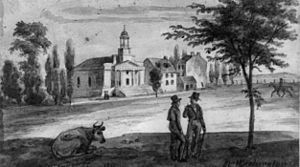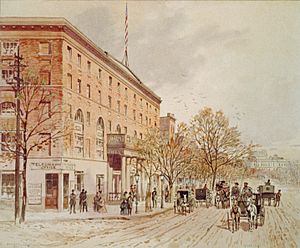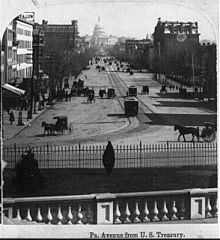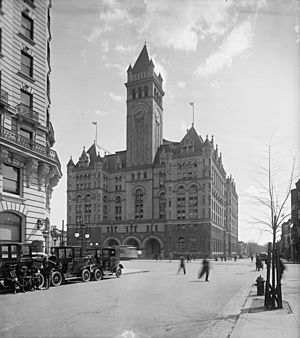Pennsylvania Avenue National Historic Site facts for kids
Quick facts for kids Pennsylvania Avenue National Historic Site |
|
|---|---|

Looking southeast down Pennsylvania Avenue N.W. in 2006. Freedom Plaza is in the foreground, with its marble inlay of the L'Enfant Plan's 1791 street-grid diagram of Washington, D.C., visible on the ground. The tall building on the left behind the trees is 1111 Pennsylvania Avenue. The Old Post Office Pavilion (former General Post Office for the old United States Post Office Department) is visible to the right, and the United States Capitol is in the far distance to the southeast.
|
|
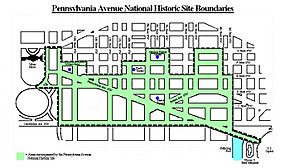 |
|
| Location | Washington, D.C., U.S. |
| Area | 20.6 acres (8.3 ha) |
| Established | September 30, 1965 |
| Governing body | National Park Service, U.S. Dept. of the Interior |
| Website | Pennsylvania Avenue National Historic Site |
|
Pennsylvania Avenue National Historic Site
|
|
| NRHP reference No. | 66000865 |
| Added to NRHP | October 15, 1966 |
The Pennsylvania Avenue National Historic Site is a special place in Washington, D.C.. It was created on September 30, 1965, to protect important buildings and areas. This historic site includes famous spots like Pennsylvania Avenue NW itself, which stretches from the White House to the United States Capitol. It also features the Treasury Building, Freedom Plaza, Ford's Theatre, and Judiciary Square.
Many people call Pennsylvania Avenue "America's Main Street." It's a very important road in American politics. When marches or events happen here, they carry a lot of meaning.
Contents
Exploring the History of Pennsylvania Avenue
How Pennsylvania Avenue Was Built
Before European settlers arrived, the Piscataway Native American tribe lived near the Potomac River. The land that became Pennsylvania Avenue was first owned by David Burns in 1774.
The Constitution of the United States said there would be a special district for the U.S. government. In 1790, President George Washington chose the current spot for Washington, D.C. He picked Pierre L'Enfant to design the new city. L'Enfant's plan included Pennsylvania Avenue as a key road. It was meant to connect the "president's palace" (now the White House) with the Capitol building.
Pennsylvania Avenue was officially created on April 14, 1792. Workers were ordered to clear the path between the president's house and the Capitol. The name "Pennsylvania Avenue" first appeared in a letter in December 1791.
Clearing the avenue didn't start until 1796. Parts of it were very wet and swampy, earning it the nickname "Great Serbonian Bog." This marshy area was later filled in starting in 1816. In 1800, the avenue was cleared, and a narrow stone footpath was built. A stone bridge was also built over Tiber Creek, later replaced by a brick arch.
President Thomas Jefferson ordered the avenue to be widened and improved in 1803. Benjamin Henry Latrobe, an architect, oversaw this work. He created three lanes separated by rows of trees. More improvements were made over the years, including new paving materials like macadam and asphalt.
Growth and Development of the Area
The historic site grew slowly until the 1850s. However, some important "firsts" happened here. The first buildings on Pennsylvania Avenue were row houses built in 1794. These buildings later served as the first headquarters for government departments like the United States Department of State. The city's first street lamps were also installed nearby in 1801.
Center Market, the city's first food market, opened in 1801. It became a busy center for businesses. The second inauguration of Thomas Jefferson in 1805 was the first to feature a procession down Pennsylvania Avenue.
The city's first school, the Western School, opened in 1806. The first sewer pipe was laid under the avenue in 1829. By 1835, the street was mostly lined with two- to four-story row houses. The first train station was also located here for a time. The National Theatre opened in 1835, followed by other theaters.
President Andrew Jackson approved the building of the Treasury Building in 1836. This large building changed the path of Pennsylvania Avenue and blocked the view of the White House. The city's first stock brokerage opened in 1837.
In the 1860s, parts of the area became run-down, even as the avenue itself improved. Pennsylvania Avenue was lit with gas streetlights in 1851, making it one of the few well-lit streets in the city. A horse-drawn trolley line was built along the street in 1862.
The southern part of the district often flooded in the late 1800s. Floodwaters were so high that rowboats were used on the avenue.
Washington's first Chinatown appeared in this area around 1884. It was a lively community until 1935. At that time, new government buildings like the National Archives Building forced Chinatown to move to its current location.
Efforts to improve the area began around 1890. A new 12-story Romanesque Revival Post Office Department headquarters was approved in 1880. This building, completed in 1899, was meant to boost the economy. It was the city's first building with a steel frame and built-in electrical wiring. However, it didn't bring the expected economic growth.
In 1900, Congress formed the McMillan Commission to plan for Washington, D.C.'s development. Their plan suggested making Pennsylvania Avenue more beautiful and adding new government buildings.
The District Building was built in 1908.
Over the next few years, new agencies were created to oversee building designs and construction. In 1926, the Public Buildings Act allowed for the construction of the Federal Triangle complex. This project helped make the Pennsylvania Avenue National Historic Site the "monumental core" of the city.
Protecting and Renewing the Site
By the 1950s, many homes and shops on the north side of Pennsylvania Avenue were falling apart. President John F. Kennedy noticed this during his inauguration parade in 1961. He wanted to redevelop the area.
A plan was created to build new mixed-use buildings with theaters, restaurants, shops, and apartments. The plan also included new plazas.
After President Kennedy's death in 1963, President Lyndon B. Johnson continued the plan at the request of Jacqueline Kennedy. A special commission was formed to move the plan forward.
To help with redevelopment, the government decided to put the area under the control of the National Park Service. This meant it would be designated a national historic site. On September 30, 1965, the avenue and several blocks around it were officially named a national historic site. It was added to the National Register of Historic Places in 1966.
Pennsylvania Avenue is often called "America's Main Street" because of its importance. It links the three branches of government: the legislative (Congress), judicial (Supreme Court), and executive (President). Marches and protests on the avenue are very visible and important for groups wanting to make their voices heard.
Making the Avenue Better
Efforts to renew Pennsylvania Avenue began in 1965. The first new building under the master plan was constructed that year.
In 1965, President Johnson created the Temporary Commission on Pennsylvania Avenue. This group was tasked with planning and recommending laws for the redevelopment. They wanted to make sure no buildings were built that didn't fit the plan.
However, redevelopment was slow. Landowners didn't want to invest if their property might be taken by the government. The Temporary Commission struggled and eventually stopped working in 1969 due to lack of funds.
In 1969, Daniel Patrick Moynihan, a presidential advisor, suggested a new approach. He proposed creating a government-owned company with funds to encourage redevelopment. Congress approved this idea in 1972, and President Richard Nixon signed the bill into law.
The Pennsylvania Avenue Development Corporation (PADC) was created in 1973. The PADC wanted to focus more on shops and housing. One of its first projects was Market Square, a mixed-use area with homes, shops, and a new memorial. The PADC also decided to keep historic buildings like the Willard Hotel and the Old Post Office Pavilion.
The PADC asked Congress for money to buy land and improve public spaces. Over the next 20 years, the PADC convinced private companies to invest over $1.5 billion. They also improved public areas, redesigned the avenue, and built seven new plazas. These changes included special lighting and benches that could be moved for parades.
The Pennsylvania Avenue Development Corporation was closed down in 1996.
Modern Efforts to Improve the Avenue
By the 2010s, parts of the historic district were showing wear and tear. The lighting was not good at night, and sidewalks and plants were deteriorating. Also, there were not many shops or restaurants in some federal buildings, which meant fewer people walked around at night. This made the street feel less safe after dark.
In 2014, the National Capital Planning Commission (NCPC) started a new "Pennsylvania Avenue Initiative." This project involves many government agencies and private landowners. Their goal is to find solutions for both short-term and long-term improvements.
Later in 2014, a bill was introduced to the Council of the District of Columbia. This bill aimed to bring back a similar organization to the PADC, but controlled by the District's government. This showed that people felt Pennsylvania Avenue still needed more revitalization.
Key Events on Pennsylvania Avenue
Many important moments in American history have happened within the Pennsylvania Avenue National Historic Site. The avenue is a main spot for political parades and protests.
Some sad events also took place here, like assassinations. President Abraham Lincoln was assassinated at Ford's Theatre in 1865. President James A. Garfield was shot in a train station on July 2, 1881. Before it was a historic site, six presidential funeral processions traveled down Pennsylvania Avenue, including President John F. Kennedy's in 1963.
The site has also seen major military celebrations. In May 1865, after the American Civil War, over 200,000 soldiers marched down Pennsylvania Avenue in a "Grand Review" before President Andrew Johnson. This massive parade took two full days. Later, Admiral George Dewey led a parade in 1899 after the Spanish-American War, and General John J. Pershing led the American Expeditionary Force in 1919 after World War I.
The area has also been the location of important political protests. In 1894, Jacob Coxey led a march of 400 unemployed workers, known as Coxey's Army. This was the first major popular protest march on Washington. On March 3, 1913, Alice Paul led the National American Woman Suffrage Association in a parade down Pennsylvania Avenue. They were demanding the right for women to vote. This march was a key event in the fight for women's suffrage. Because this group won the right to march, it set a rule that almost any group could march on Pennsylvania Avenue.
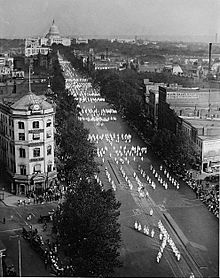
This rule was used 12 years later. In 1925 and 1926, about 40,000 members of the Ku Klux Klan marched on Pennsylvania Avenue. These marches showed the height of the Klan's power.
Another big protest on the avenue ended in tragedy. In June 1932, thousands of homeless World War I veterans and their families, known as the Bonus Army, came to Washington. They were protesting for better benefits. When they were allowed to march down Pennsylvania Avenue, it made many Americans see them as patriots. However, on July 28, 1932, President Herbert Hoover ordered General Douglas MacArthur to remove them. MacArthur led soldiers and tanks down the avenue to clear the area. A Bonus marcher was killed during this event.
Sometimes, just the threat of a march down Pennsylvania Avenue has led to political change. For example, in 1941, civil rights leader A. Philip Randolph planned a march of 100,000 African American men. He wanted to pressure the government to protect against discrimination. President Franklin D. Roosevelt tried to stop the march, but Randolph refused. Roosevelt then issued an order that banned discrimination in defense contracts, and the march was called off.
Pennsylvania Avenue as a Symbol
The historic site is often used as a political symbol in the United States. People often talk about the distance between the White House and the Capitol on Pennsylvania Avenue as a way to describe differences in political ideas between the President and Congress. It's also seen as a symbol for the separation of powers under the United States Constitution. The area is also a way to refer to the U.S. government itself. For example, President Franklin D. Roosevelt was sometimes called "the sphinx of Pennsylvania Avenue."


